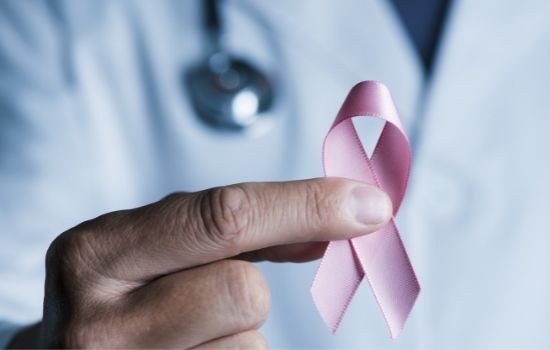Attention GCI Patients — Effective October 6, 2025, the GCI Oak Lawn location will be closed. All patients of GCI Oak Lawn will be seen at our Chicago Ridge location at 10604 Southwest Highway, Suite 109, Chicago Ridge, IL 60415.
June 19, 2024
Recognizing and Managing Recurrent Breast Cancer: Signs and Treatment Options

Breast cancer is often successfully treated, especially when it is detected early. That fact remains, however, breast cancer returns for some patients after the initial treatment plan is complete. This is what is known as recurrent breast cancer.
Recurrent breast cancer is caused by cancer cells that were not completely destroyed during the initial treatment process. Those cells can lay dormant (inactive) for several months, or years before they start to grow again.
While breast cancer recurrence is most common in the first five years after treatment is complete, It can recur months, or many years, following treatment. Your cancer care team will develop a new treatment plan based on the type of recurrence and extent of cancer when it’s found.
Types of Breast Cancer Recurrence
Breast cancer can return to the same place it was initially, another area of the breast, or an entirely different area of the body. Your oncologist will determine the type of recurrence based on where it recurred.
Local
Local breast cancer recurrence refers to cancer that returns in the same location as the original breast cancer diagnosis.
Regional
Regional breast cancer recurrence indicates the cancer has returned in nearby lymph nodes.
Distant
Distant breast cancer recurrence (also known as metastatic breast cancer) means the cancer has developed in other areas of the body. While this can be virtually any body part, the bones, liver, or lungs are the most common places for breast cancer to spread.

What Makes Breast Cancer More Likely to Recur?
While there is no way to determine for sure if breast cancer will come back, there are some possible risk factors to keep in mind, including:
Larger Tumor Size: Larger tumors are associated with a higher risk of the cancer returning.
Younger Age: Individuals under the age of 35 at the time of their original diagnosis have a higher risk of recurrent breast cancer.
Lack of Radiation Treatment Following Lumpectomy: Most people who undergo a lumpectomy (wide local excision) for breast cancer also receive radiation therapy to reduce the risk of recurrence. Skipping radiation therapy increases the risk of local recurrence. Read our blog to understand radiation therapy for breast cancer treatment.
Cancer Cells with Certain Characteristics: Individuals with triple-negative breast cancer (which lacks receptors for estrogen, progesterone, and HER2) are at a higher risk of recurrence.
Inflammatory Breast Cancer: This type of breast cancer carries a higher risk of local recurrence.
Obesity: A higher body mass index (BMI) is linked to an increased risk of breast cancer recurrence.
Lymph Node Involvement: Cancer in nearby lymph nodes at the time of the original diagnosis increases the likelihood of recurrence.
Positive or Close Tumor Margins: During breast cancer surgery, the goal is to remove the cancer along with a small amount of surrounding normal tissue. If the edges of the removed tissue (margins) are free of cancer cells under a microscope, it is considered a negative margin. However, if cancer cells are present at the edges (positive margin) or if the margin is close, the risk of recurrence is higher.
Lack of Endocrine Therapy for Hormone Receptor-Positive Breast Cancer: Not receiving endocrine therapy for hormone receptor-positive breast cancer can increase the risk of recurrence.
Can You Tell if Breast Cancer is Recurring?
The signs and symptoms of recurrent breast cancer can vary from patient to patient and may look different based on where the cancer comes back. It’s important that you follow your doctor’s recommended follow-up imaging schedule to look for cancer that can’t be detected by feeling the breast.
If the cancer returns in the breast tissue, you may experience the following symptoms:
Discharge from the nipple
New lump in the breast
Irregular firmness in the breast
Skin inflammation
Redness
Other skin changes
Cancer in the chest wall following a mastectomy (the surgical removal of one or both breasts) may have the following signs and symptoms:
Nodules form on or under the skin of the chest wall
New thickening near the scar line of the mastectomy
Regional breast cancer typically includes a lump or swelling in lymph nodes located in the following areas:
In your neck
Under your arm
Near or above your collarbone
Signs and symptoms associated with distant breast cancer recurrence typically include:
Ongoing and worsening pain, such as the chest or hip
Sudden and unintentional weight loss
Persistent cough
Bone pain
Jaundice (yellowing of the skin or eyes)
Difficulty breathing
Seizures
Diagnosing Recurrent Breast Cancer
There are two primary ways recurrent breast cancer is found: the patient notices something, or the follow-up tests, such as a PET-CT or PET-MRI, show a new growth before it can be felt. Just as with the initial diagnosis, it’s best to find recurrent breast cancer as early as possible.
Blood tests are also used to look for tumor markers. If these start to rise, the oncologist will run additional tests to find the source of the increase.
Treatments for Local, Regional, and Distant Breast Cancer Recurrence
Your treatment plan is influenced by many factors, especially cancer’s location and the treatments you’ve had previously. For example, if you had radiation therapy previously, it is unlikely your oncologist will suggest that type of treatment again. Here is what to expect for local, regional, or distant breast cancer recurrence.
Local Breast Cancer Recurrence Treatment Options
Mastectomy (breast removal) might be the suggested treatment if your initial surgery was a lumpectomy to preserve the breast. Additionally, nearby lymph nodes will be removed if they weren’t already done so in the first surgery.
Radiation will likely be recommended following surgery if you didn’t already have it since there are considerable side effects.
Hormone therapy, targeted therapy, immunotherapy, chemotherapy, or a combination of these treatments may be recommended after surgery and/or radiation. Typically, hormone therapy is suggested first if surgery or radiation is not an option.
Hormone therapy blocks estrogen and progesterone, promoting cancer cell growth with medications. This type of treatment helps kill cancer cells in the body that are hormone-receptor-positive.
Targeted therapy focuses on cancer cells that produce excess HER2 protein. Targeted medications go into the bloodstream and can treat all areas of the body. Targeted drugs may be suggested when chemotherapy is not effective. Targeted therapy may also make other treatments more effective.
Immunotherapy uses medications to boost your immune system, making it possible to fight the cancer cells.
Chemotherapy, which uses drugs to kill cancer cells, is often used to help reduce the chances of cancer recurrence.
Treatment for Regional Breast Cancer Recurrence
Surgery, such as a lumpectomy or mastectomy, is typically the most common course of treatment and is used to remove the cancer and nearby lymph nodes if not already done so with the first surgery.
Radiation therapy is sometimes used following surgery. It may be the primary treatment in some cases, but only if you did not receive radiation during your initial treatment.
Drug treatments, such as chemotherapy, targeted therapy, or hormone therapy, may be suggested as the treatment for regional recurrent cancer. Sometimes it is recommended following surgery or radiation therapy.
Methods for Treating Distant Breast Cancer Recurrence
Hormone therapy is usually the first treatment if your cancer is hormone receptor-positive. This treatment has fewer side effects than chemotherapy.
Chemotherapy is usually recommended if your cancer is hormone receptor-negative or if hormone therapy has stopped working.
Targeted therapy may be an option if your cancer cells respond to targeted medications.
Immunotherapy helps your own body's immune system fight cancer by interfering with the cell proteins that help cancer cells hide from immune system cells. Sometimes, immunotherapy is combined with chemotherapy.
Bone-building medications can reduce the risk of fractures and help manage bone pain.
Radiation therapy can be recommended to manage symptoms.
You should work with your breast cancer doctor to determine the best course of action based on where your breast cancer has returned and the best possibility for a successful outcome. In addition to the factors above, the specifics about the type of recurrent breast cancer you have will largely determine the treatments available to you. Typically, you can expect a combination of treatment methods.
Comprehensive Recurrent Breast Cancer Treatment in South Chicago
Breast cancer research, including clinical trials available to patients at Affiliated Oncologists, has made it possible for new and effective treatments to be FDA approved that help treat metastatic and recurrent breast cancer. This brings promising news for patients diagnosed with recurrent breast cancer.

The breast cancer specialists at Affiliated Oncologists are available to assist with treatment for recurrent cancer, even if you did not receive your initial treatment with us. We also provide second opinions on treatment plans. Our offices are located in the south Chicago suburbs including Chicago Ridge, Mokena, Hazel Crest, Palos Heights, New Lenox, Oak Lawn and Orland Park.
Categories: Breast Cancer